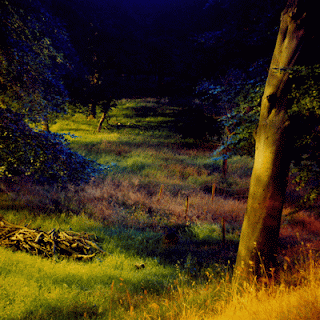Her collection called 'Sharpes Wood' was nominated for the Prix Pictet EARTH Photographic Prize. The ' Sharpes wood' pieces are taken at night, thereby showing us what can only be seen by the camera. She exhibits her work at various galleries throughout the country.
Dracup's work is tinged "with myth and memory". Her interest in woods and night harks back to childish fear and excitement of the unknown. Her work verges almost upon the fairytale. 'Sharpes Wood' was comissioned by The Impressions Gallery and took four years to finish.

These two photos I have chosen from the 'Sharpes Wood' collection.
There are twenty three images to this series.
The first picture was taken at night and leads the eye into the middle distance. The compostion has a tree lit by the flash in the foreground and then the light fades as it goes into the shadowy background. The picture is very haunting and the colour almost unbelievable. It could be from any time. I think that she has enhanced the colours to add to the drama. There are various shades of gold, purple and a cold blue. These works are viewed in exhibitions around the country. I would like to be able to use her work as a reference for some of my final images as I enjoy the ways in which she plays with light and colour. I am a fan of changing the Colour Enhancement.
The second picture that I have chosen in this series shows the cool reflections of trees in a woodland lake. Again this is taken at night and the depth of the background contrasts well with the muted greens of the middle and foreground. The picture is at one and the same time mysterious and yet soporific. The atmosphere is slightly unnerving as though the viewer is in a state of trance waiting for something to happen.
'Whitby' (Moonlight) 2010
This picture is number ten of a series of eighteen from the 'Chasing the Gloaming' collection. It is a beautiful photo of moonlight reflecting on the sea. Again it has the silhouette theme that I like and the lighting is so subtle that it almost looks like a painting. It is a very romatic and evocative photo and is almost mesmeric. The main colours are greys and silver with the silhouette lit by an orange glow.
'Green Circle' - Tree & Moon 2011
(This photo again is from 'Chasing the Gloaming').
This photograph is circular on a green/grey background. The moon shines low through mist and trees. This photo will have been digitally manipulated with the use of the frame. It would be ideal to digitally manipulate as the setting is almost fantasy. For this body of work the photographer was much influenced by Atkinson Grimshaw (a victorian artist). Dracup was inspired by his use of light, colour, subject and location.I find that the frame transports it from photo into a piece of art.
















































